numpy.unique() 函数接受一个数组,去除其中重复元素,并按元素由小到大返回一个新的无元素重复的元组或者列表。
1. 参数说明
|
1 |
numpy.unique(ar, return_index=False, return_inverse=False, return_counts=False, axis=None, *, equal_nan=True) |
ar:输入数组,除非设定了下面介绍的axis参数,否则输入数组均会被自动扁平化成一个一维数组。
return_index:(可选参数,布尔类型),如果为True则结果会同时返回被提取元素在原始数组中的索引值(index)。
return_inverse:(可选参数,布尔类型),如果为True则结果会同时返回元素位于原始数组的索引值(index)。
return_counts:(可选参数,布尔类型),如果为True则结果会同时每个元素在原始数组中出现的次数。
axis:计算唯一性时的轴
返回值:返回一个排好序列的独一无二的数组。
2. 示例
2.1. 一维数组
|
1 2 |
np.unique([1, 1, 2, 2, 3, 3]) a = np.array([[1, 1], [2, 3]]) |
结果
array([1, 2, 3])
2.2. 二维数组
|
1 2 |
a = np.array([[1, 0, 0], [1, 0, 0], [2, 3, 4]]) np.unique(a, axis=0) |
结果
array([[1, 0, 0], [2, 3, 4]])
2.3. 返回索引
|
1 2 |
a = np.array(['a', 'b', 'b', 'c', 'a']) u, indices = np.unique(a, return_index=True) |
结果
array([0, 1, 3])
array(['a', 'b', 'c'], dtype='<U1')
2.4. 重建输入矩阵
|
1 2 3 |
a = np.array([1, 2, 6, 4, 2, 3, 2]) u, indices = np.unique(a, return_inverse=True) u[indices] |
结果
array([1, 2, 3, 4, 6])
array([0, 1, 4, 3, 1, 2, 1])
array([1, 2, 6, 4, 2, 3, 2])
示例:尝试用参数 return_counts 解决一个小问题。
|
1 2 3 4 5 6 7 8 9 10 11 12 13 14 15 16 17 18 19 20 21 22 23 24 25 |
# coding: utf-8 import numpy as np
# 任务: 统计 a 中元素个数, 找出出现次数最多的元素 a = np.array([1, 1, 1, 3, 3, 2, 2, 2, 2, 4, 5, 5])
# numpy.unique() 测试 b = np.unique(a) print(b)
# 使用 return_counts=True 统计元素重复次数 b, count = np.unique(a, return_counts=True) print(b, count)
# 使用 zip 将元素和其对应次数打包成一个个元组, 返回元组的列表 zipped = zip(b, count) # for i, counts in zipped: # print("%d: %d" % (i, counts)) # 这里打印zipped出来, # # 下面 max()会报 # # ValueError: max() arg is an empty sequence # # 不知道为什么 >_<
# 使用 max() 函数找出出现次数最多的元素 target = max(zipped, key=lambda x: x[1]) print(target) |




